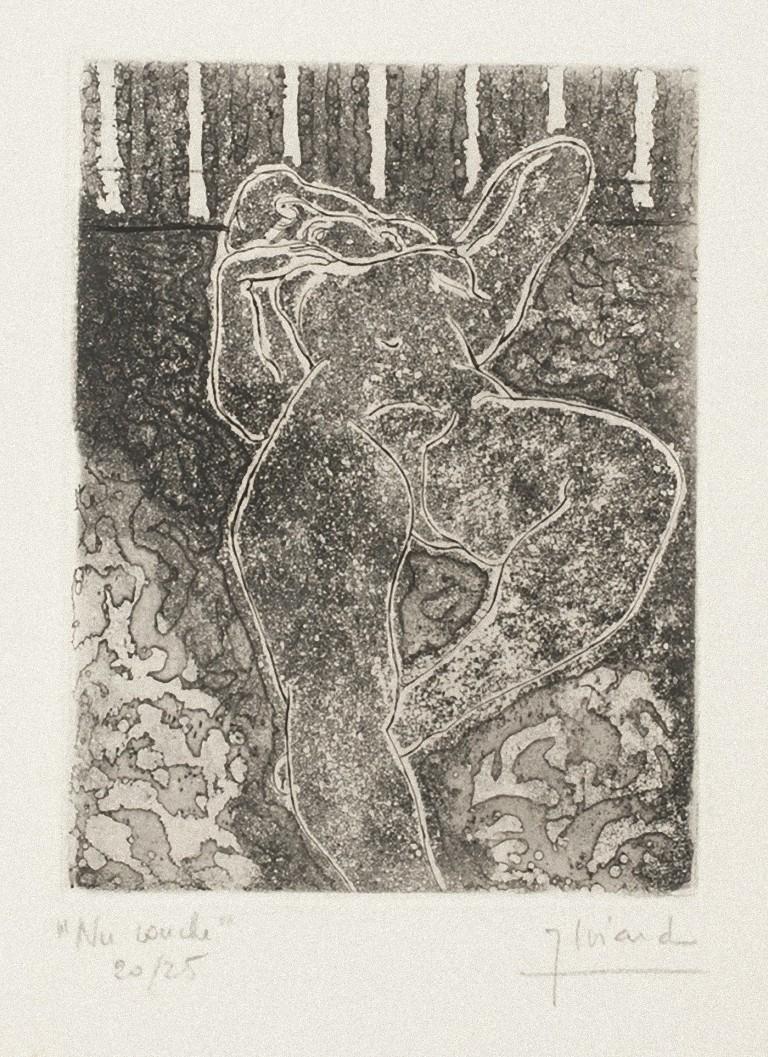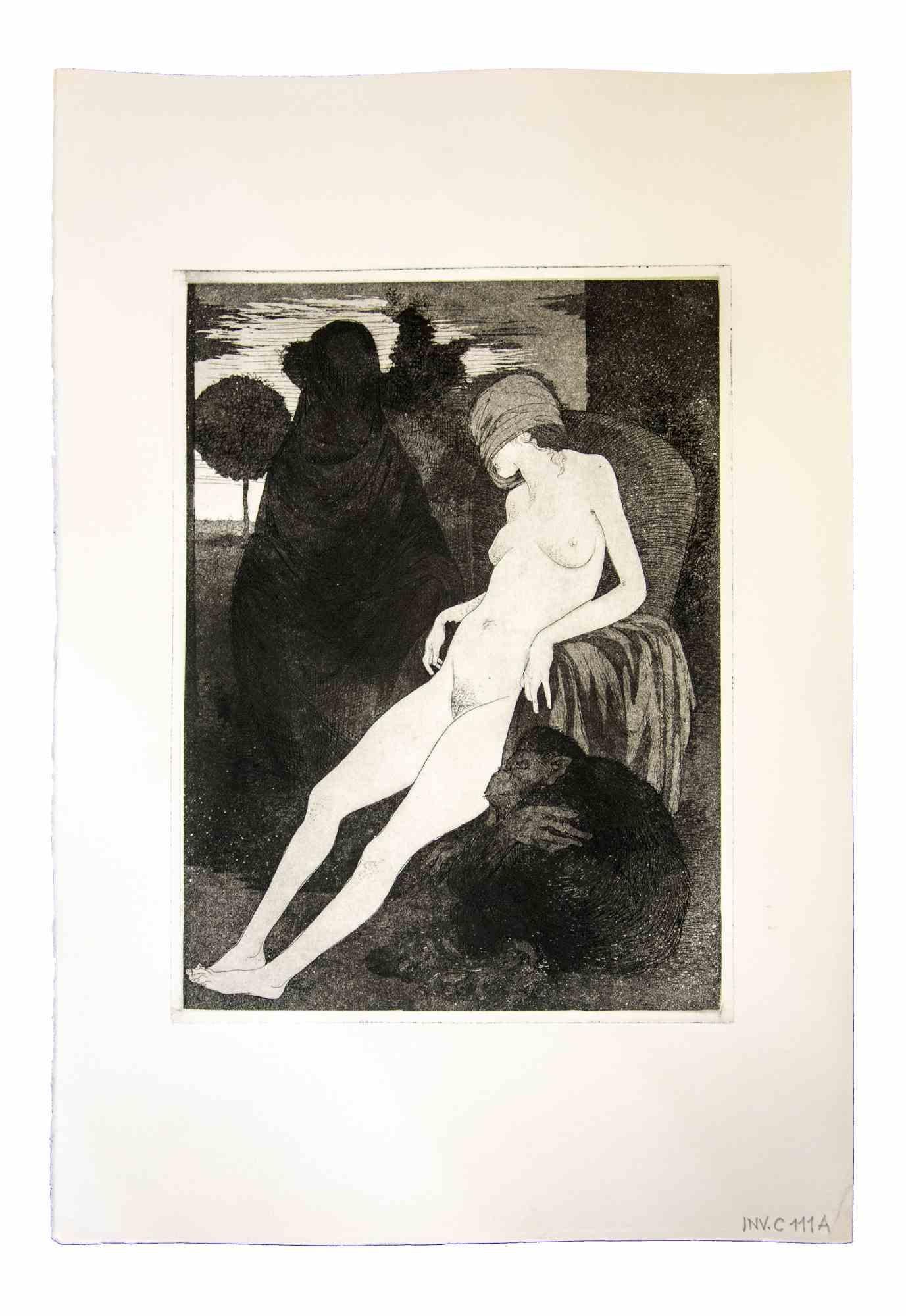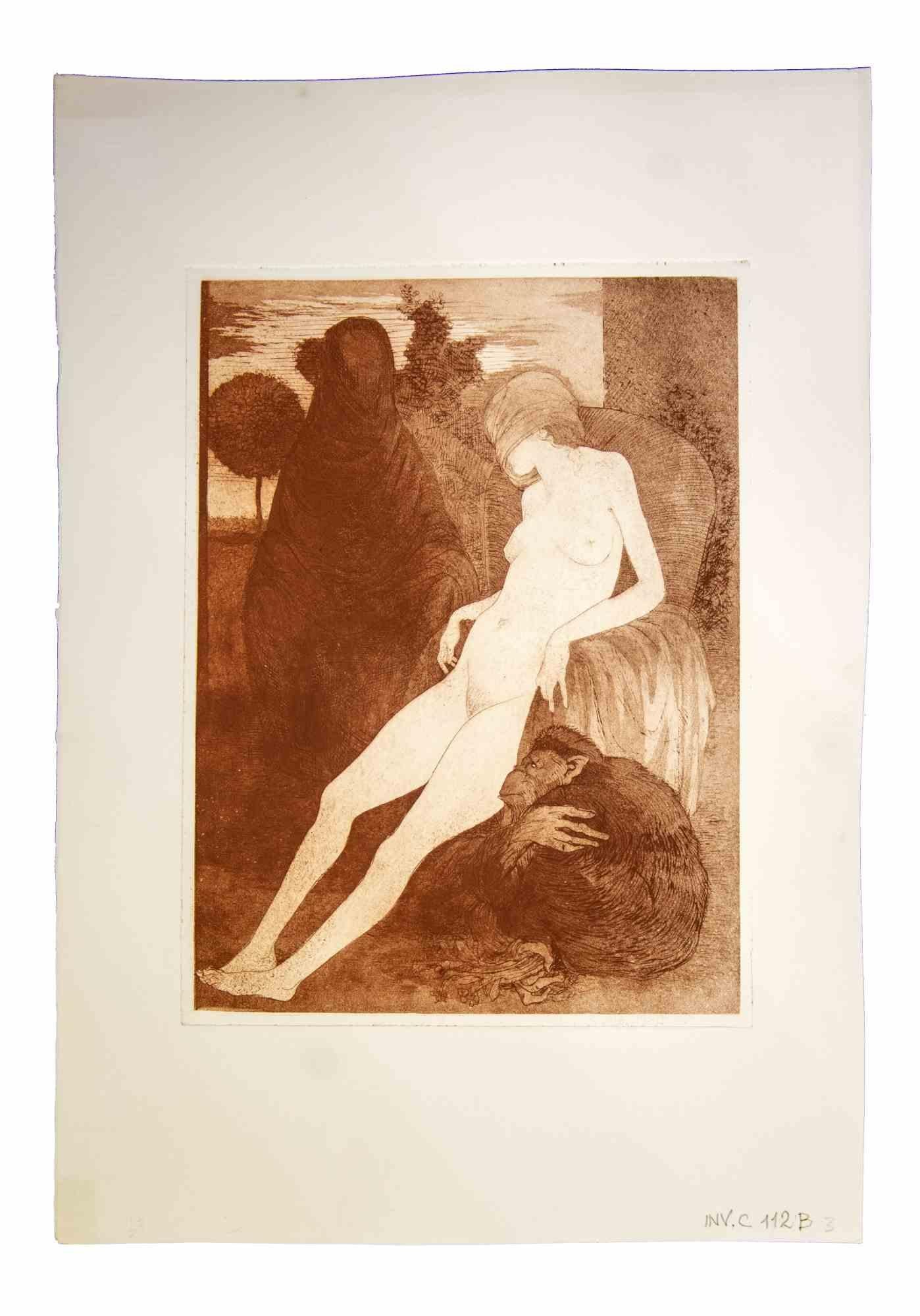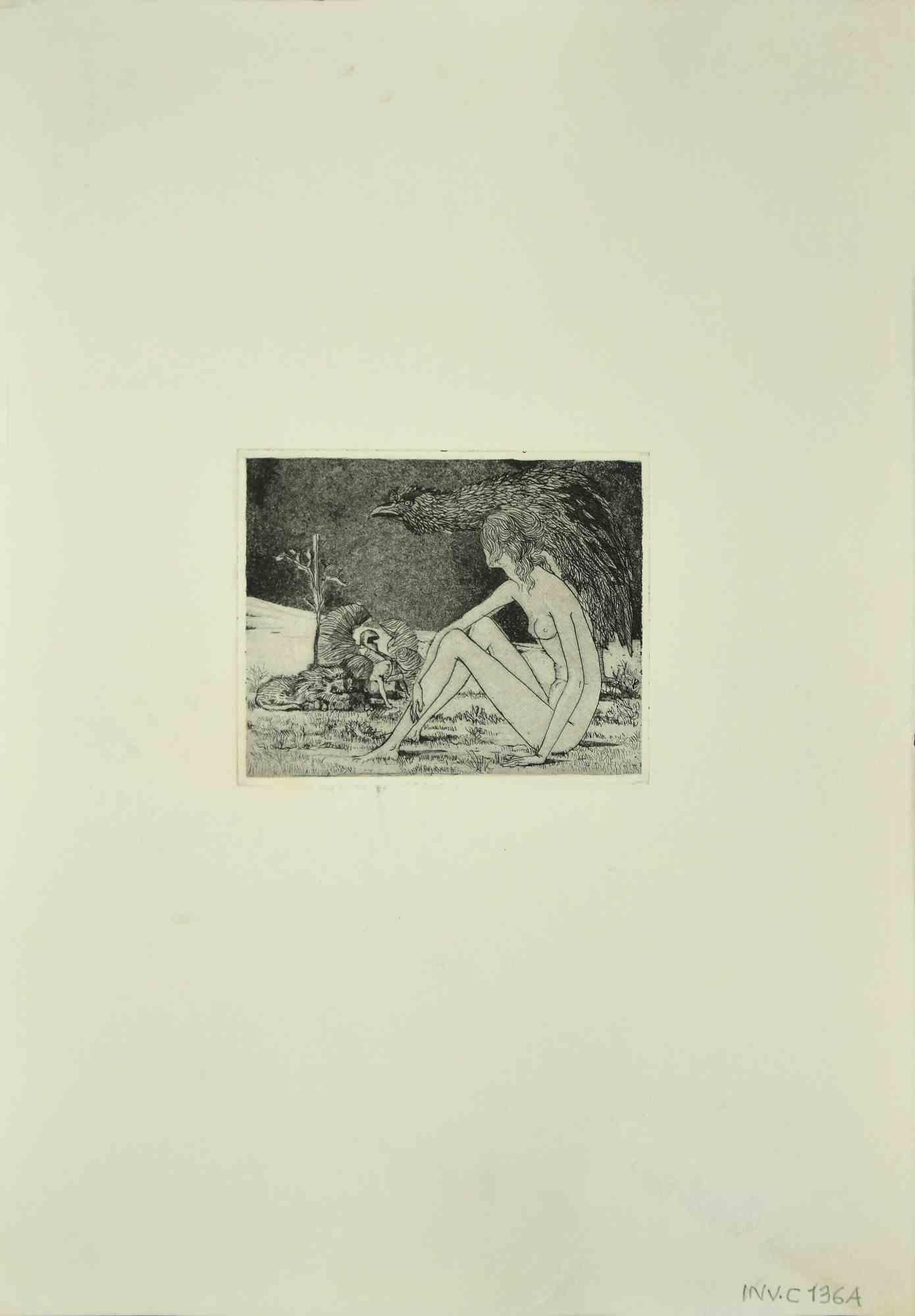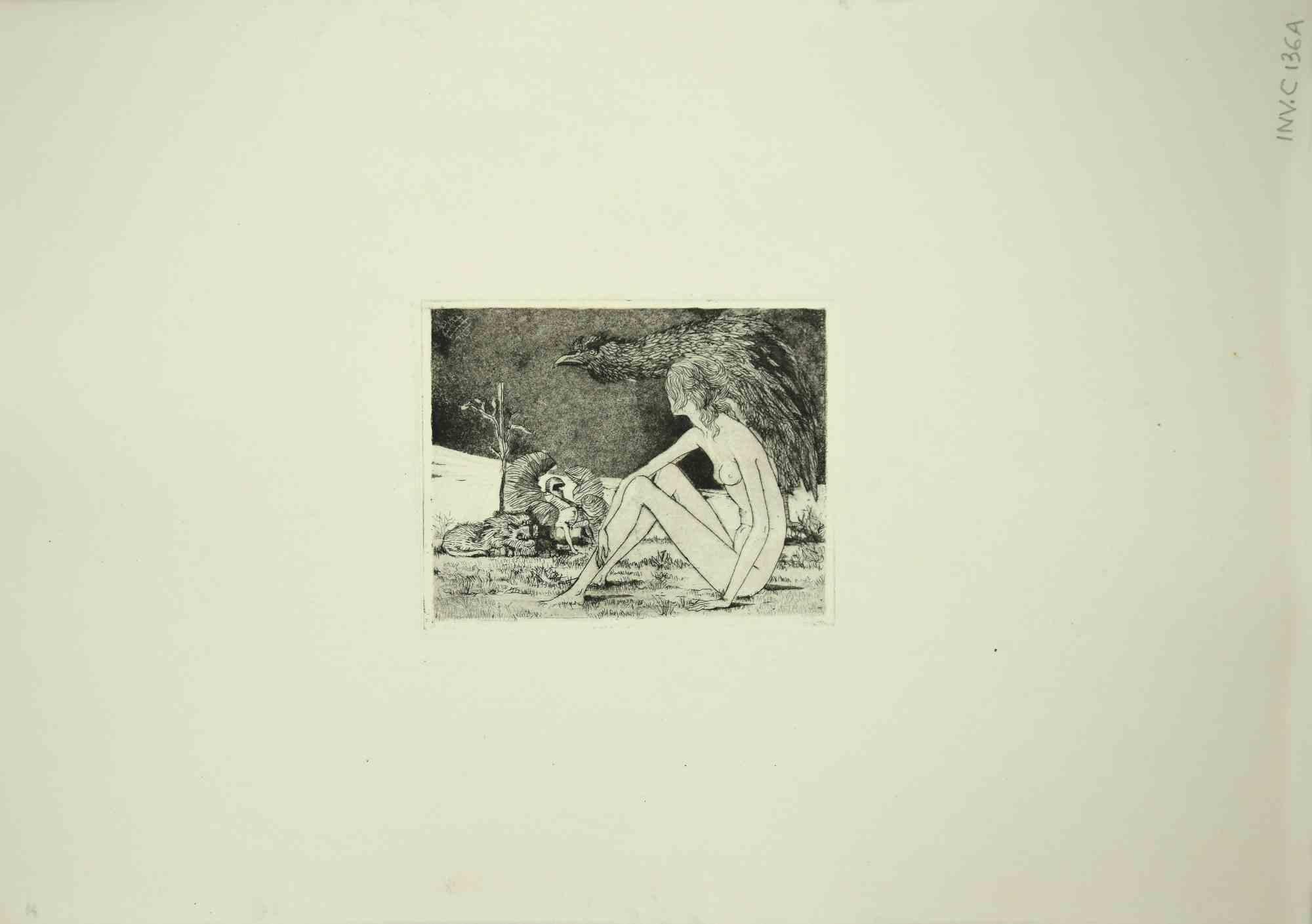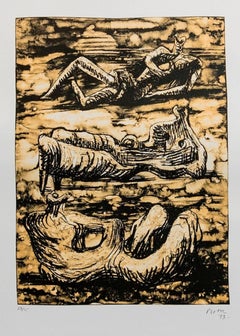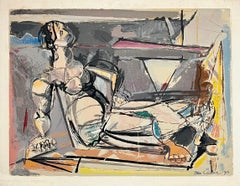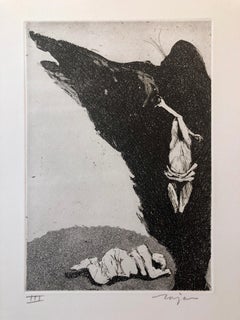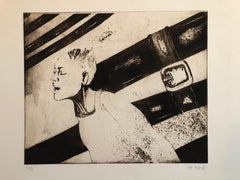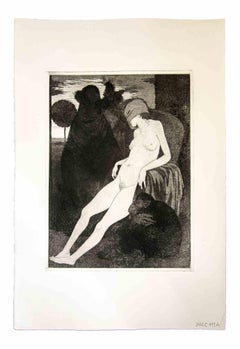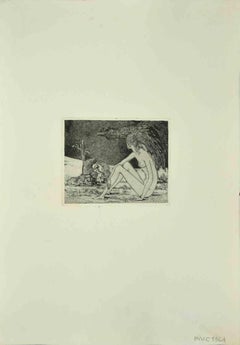Items Similar to Etching with Aquatint Print Women Reclining
Want more images or videos?
Request additional images or videos from the seller
1 of 14
Better SaiberlichEtching with Aquatint Print Women Reclining
$450
£340.63
€390.70
CA$632.52
A$696.09
CHF 365.02
MX$8,447.67
NOK 4,562.69
SEK 4,319.60
DKK 2,916.81
About the Item
Inspired by the energy within the image, fine draftsmanship, purity of line, subtlety of color, and the excitement of combining the media of etching and wood block printing makes Saiberlich’s graphics modern with classic restraint. To quote Ms. Saiberlich: “My life and my creative efforts aim to reflect a simple chorale in praise of living.”
The versatile Ms. Saiberlich has received wide recognition not only for printmaking but for drawing, painting, and ceramics. Her work is in collections both private and institutional in east and middle west U.S. and represented by galleries in New York State, Massachusetts, Connecticut, and Canada. She has had numerous One Person Shows and given demonstrations, lectures, and television presentations.
Ms. Saiberlich holds B.S.Art, M.S. in Art, and M.F.A. degrees from the University of Wisconsin, Madison, and also Permanent Public School Teaching Certification in Wisconsin and New York State. She has taught in public and private schools, graduate and adult education programs, and was the New York correspondent for Craft Horizons, the international publication of American Craftsmen’s Council, New York City. She has made her home in Dunedin, Florida and is proud to have her studio in the Stirling Artists Studios and Gallery.
- Creator:Better Saiberlich
- Dimensions:Height: 19.5 in (49.53 cm)Width: 22.5 in (57.15 cm)
- Medium:
- Period:
- Condition:Minor wear. Please see photos.
- Gallery Location:Surfside, FL
- Reference Number:1stDibs: LU38215346972
About the Seller
4.9
Platinum Seller
Premium sellers with a 4.7+ rating and 24-hour response times
Established in 1995
1stDibs seller since 2014
1,810 sales on 1stDibs
Typical response time: 1 hour
- ShippingRetrieving quote...Shipping from: Surfside, FL
- Return Policy
Authenticity Guarantee
In the unlikely event there’s an issue with an item’s authenticity, contact us within 1 year for a full refund. DetailsMoney-Back Guarantee
If your item is not as described, is damaged in transit, or does not arrive, contact us within 7 days for a full refund. Details24-Hour Cancellation
You have a 24-hour grace period in which to reconsider your purchase, with no questions asked.Vetted Professional Sellers
Our world-class sellers must adhere to strict standards for service and quality, maintaining the integrity of our listings.Price-Match Guarantee
If you find that a seller listed the same item for a lower price elsewhere, we’ll match it.Trusted Global Delivery
Our best-in-class carrier network provides specialized shipping options worldwide, including custom delivery.More From This Seller
View AllHenry Moore 1973 Lithograph edition 28/75 Sculpture Figures Reclining Nudes
By Henry Moore
Located in Surfside, FL
Henry Spencer Moore (1898 – 1986)
Moore was born in Castleford, the son of a coal miner. He became well-known through his carved marble and larger-scale abstract cast bronze sculptures, and was instrumental in introducing a particular form of modernism to the United Kingdom later endowing the Henry Moore Foundation, which continues to support education and promotion of the arts.
After the Great War, Moore received an ex-serviceman's grant to continue his education and in 1919 he became a student at the Leeds School of Art (now Leeds College of Art), which set up a sculpture studio especially for him. At the college, he met Barbara Hepworth, a fellow student who would also become a well-known British sculptor, and began a friendship and gentle professional rivalry that lasted for many years. In Leeds, Moore also had access to the modernist works in the collection of Sir Michael Sadler, the University Vice-Chancellor, which had a pronounced effect on his development. In 1921, Moore won a scholarship to study at the Royal College of Art in London, along with Hepworth and other Yorkshire contemporaries. While in London, Moore extended his knowledge of primitive art and sculpture, studying the ethnographic collections at the Victoria and Albert Museum and the British Museum.
Moore's familiarity with primitivism and the influence of sculptors such as Constantin Brâncuși, Jacob Epstein, Henri Gaudier-Brzeska and Frank Dobson led him to the method of direct carving, in which imperfections in the material and marks left by tools became part of the finished sculpture. After Moore married, the couple moved to a studio in Hampstead at 11a Parkhill Road NW3, joining a small colony of avant-garde artists who were taking root there. Shortly afterward, Hepworth and her second husband Ben Nicholson moved into a studio around the corner from Moore, while Naum Gabo, Roland Penrose, Cecil Stephenson and the art critic Herbert Read also lived in the area (Read referred to the area as "a nest of gentle artists"). This led to a rapid cross-fertilization of ideas that Read would publicise, helping to raise Moore's public profile. The area was also a stopping-off point for many refugee artists, architects and designers from continental Europe en route to America—some of whom would later commission works from Moore.
In 1932, after six year's teaching at the Royal College, Moore took up a post as the Head of the Department of Sculpture at the Chelsea School of Art. Artistically, Moore, Hepworth and other members of The Seven and Five Society would develop steadily more abstract work, partly influenced by their frequent trips to Paris and their contact with leading progressive artists, notably Pablo Picasso, Georges Braque, Jean Arp and Alberto Giacometti. Moore flirted with Surrealism, joining Paul Nash's modern art movement "Unit One", in 1933. In 1934, Moore visited Spain; he visited the cave of Altamira (which he described as the "Royal Academy of Cave Painting"), Madrid, Toledo and Pamplona. Moore made his first visit to America when a retrospective exhibition of his work opened at the Museum of Modern Art in New York City.[28]
Before the war, Moore had been approached by educator Henry Morris, who was trying to reform education with his concept of the Village College. Morris had engaged Walter Gropius as the architect for his second village college at Impington near Cambridge, and he wanted Moore to design a major public sculpture for the site.
In the 1950s, Moore began to receive increasingly significant commissions. He exhibited Reclining Figure: Festival at the Festival of Britain in 1951, and in 1958 produced a large marble reclining figure for the UNESCO building in Paris. With many more public works of art, the scale of Moore's sculptures grew significantly and he started to employ an increasing number of assistants to work with him at Much Hadham, including Anthony Caro and Richard Wentworth.
Moore produced at least three significant examples of architectural sculpture during his career. In 1928, despite his own self-described extreme reservations, he accepted his first public commission for West Wind for the London Underground Building at 55 Broadway in London, joining the company of Jacob Epstein and Eric Gill..At an introductory speech in New York City for an exhibition of one of the finest modernist sculptors, Alberto Giacometti, Sartre spoke of The beginning and the end of history...
Category
1970s Modern Abstract Prints
Materials
Lithograph
American Modernist Cubist Lithograph Screenprint "Reclining Woman" Max Weber
By Max Weber
Located in Surfside, FL
Reclining Cubist Nude Woman
Max Weber (April 18, 1881 – October 4, 1961) was a Jewish-American painter and one of the first American Cubist painters who, in later life, turned to more figurative Jewish themes in his art. He is best known today for Chinese Restaurant (1915), in the collection of the Whitney Museum of American Art, "the finest canvas of his Cubist phase," in the words of art historian Avis Berman.
Born in the Polish city of Białystok, then part of the Russian Empire, Weber emigrated to the United States and settled in Brooklyn with his Orthodox Jewish parents at the age of ten. He studied art at the Pratt Institute in Brooklyn under Arthur Wesley Dow. Dow was a fortunate early influence on Weber as he was an "enlightened and vital teacher" in a time of conservative art instruction, a man who was interested in new approaches to creating art. Dow had met Paul Gauguin in Pont-Aven, was a devoted student of Japanese art, and defended the advanced modernist painting and sculpture he saw at the Armory Show in New York in 1913.
In 1905, after teaching in Virginia and Minnesota, Weber had saved enough money to travel to Europe, where he studied at the Académie Julian in Paris and acquainted himself with the work of such modernists as Henri Rousseau (who became a good friend), Henri Matisse, Pablo Picasso, and other members of the School of Paris. His friends among fellow Americans included some equally adventurous young painters, such as Abraham Walkowitz, H. Lyman Sayen, and Patrick Henry Bruce. Avant-garde France in the years immediately before World War I was fertile and welcoming territory for Weber, then in his early twenties. He arrived in Paris in time to see a major Cézanne exhibition, meet the poet Guillaume Apollinaire, frequent Gertrude Stein's salon, and enroll in classes in Matisse's private "Academie." Rousseau gave him some of his works; others, Weber purchased. He was responsible for Rousseau's first exhibition in the United States.
In 1909 he returned to New York and helped to introduce Cubism to America. He is now considered one of the most significant early American Cubists, but the reception his work received in New York at the time was profoundly discouraging. Critical response to his paintings in a 1911 show at the 291 gallery, run by Alfred Stieglitz, was an occasion for "one of the most merciless critical whippings that any artist has received in America." The reviews were "of an almost hysterical violence." He was attacked for his "brutal, vulgar, and unnecessary art license." Even a critic who usually tried to be sympathetic to new art, James Gibbons Huneker, protested that the artist's clever technique had left viewers with no real picture and made use of the adage, "The operation was successful, but the patient died."[8] As art historian Sam Hunter wrote, "Weber's wistful, tentative Cubism provided the philistine press with their first solid target prior to the Armory Show."
The Cellist...
Category
Mid-20th Century Cubist Abstract Prints
Materials
Screen
Surrealist Figurative Aquatint Etching California Modernist Sculptor Artist
By Jack Zajac
Located in Surfside, FL
Jack Zajac, American, born 1929
1964 Etching and aquatint hand printed on Fabriano paper, pencil signed and editioned.
Edition Roman Numeral III
Image: 12 9/16 x 8 5/8 in. (31.9 x 2...
Category
1960s Surrealist Figurative Prints
Materials
Etching, Aquatint
Woman in Agony or Ecstasy, Modernist Israeli Etching
By Oded Feingersh
Located in Surfside, FL
Oded Feingersh. painter and chemical engineer. Born in Jerusalem. Graduate of Bezalel Art Academy, studied art in Paris.
Education
1960–63 Bezalel Academy of Art & Design,, Jerusalem
1979-83 Avshalom Institute, Tel-Aviv Geography of Israel
1965–68 Paris, Brussels and Madrid
Feingersh's work ranges between social realism, naturalism, pop-art and surrealism. As a vagabond-artist, he draw endless influences from all around the world, his world is abundant with personal and collective mythology, classic and modern influences, from the erotic to medieval art to Hieronymus Bosch and Thomas Huffman.
Selected one person exhibition:
1964 Chermernisky Art Gallery, Tel-Aviv
1966 Tournesol Galerie, Paris
1966 Montjoie Gallerie, Brussels
1967 Campo Gallerie, Antwerp
1968 Sala Amadis, Madrid
1969 Views of Fear, Engel Gallery, Jerusalem
1970 Psychic Drawings, Dugit Gallery, Tel-Aviv
A secret Agent's Battles Against International Communism, Engel Gallery
1975 Tel Aviv Museum
1977 Arta Gallery, Jerusalem
1978 Ella Gallery, Jerusalem
1979 Fontana Gallery, Stockholm
1982 Art Basel Fair, Tiroche Gallery
1982 Saphir Gallery, Paris
1983 Puffing, Radius Gallery, Tel-Aviv
2002 Narcissism, Sculpture Gallery, Ramat Gan
2007 Through the Back, Danon Gallery, Tel Aviv
2002 Old & New, the Art Workshop, Yavne.
2010 Film Noir bin Color, Ramat Gan Museum of Art, Ramat Gan
2011 Dialogue, Tal gallery, Kfar Vradim
Selected group exhibitions:
1964 Youngsters 64, Painters Association, Tel Aviv
1966 Lefranc Prize, Maison de Beaux-Arts, Paris
1968 The Autumn Exhibition, Tel-Aviv Museum, Rubinstein Pavillion
1969 Venus (10+ Group), Gordon Gallery, Tel Aviv
The Winter Exhibition,Mabat - Art Gallery, Tel Aviv
Artists: Igael Tumarkin, Aharon Giladi, Moshe Givati, Tuvia Beeri, Yaacov
Dorchin, Dudu Feingersh, Shimon Avny, Avigdor Stematsky.
1970 Graphic...
Category
20th Century Modern Landscape Paintings
Materials
Etching
Erotic Nude French Surrealist Aquatint Etching Photo Collage Silkscreen Print
By Zvi Milshtein
Located in Surfside, FL
This is numbered by hand in pencil and signed in pencil. An erotic nude etching.
Zwy Milshtein (Zvi Tzvi Milstein) BIOGRAPHY 1934 Born in Kishinev (Bessarabia) Russian, Romanian reg...
Category
20th Century Expressionist Portrait Prints
Materials
Etching, Aquatint
Surrealist Figurative Aquatint Etching California Modernist Sculptor Artist
By Jack Zajac
Located in Surfside, FL
Jack Zajac, American, born 1929
1964 Etching and aquatint hand printed on Fabriano paper, pencil signed and editioned.
This one depicts winged angels.
Edition Roman Numeral III
Ima...
Category
1960s Surrealist Figurative Prints
Materials
Etching, Aquatint
You May Also Like
Reclining Nude - Original Etching on Paper - 20th Century
Located in Roma, IT
Reclining nude is a beautiful etching realized during the XX century.
In very good condition. Illegible signature. Edition of only 25 copies.
Category
20th Century Figurative Prints
Materials
Etching
Reclined Nude - Original Etching by Leo Guida - 1970
By Leo Guida
Located in Roma, IT
Reclined Nude is an original etching and aquatint realized by Leo Guida in 1970s.
Good condition for the 8 copies of the artwork.
No signature.
Leo Guida (1992 - 2017). Sensitive...
Category
1970s Contemporary Figurative Prints
Materials
Etching, Aquatint
Reclined Nude - Original Etching by Leo Guida - 1970
By Leo Guida
Located in Roma, IT
Reclined Nude is an original etching and aquatint in sanguine realized by Leo Guida in 1970s.
Good condition for the 8 copies of the artwork.
Mounted on a white cardboard (50x34 cm...
Category
1970s Contemporary Figurative Prints
Materials
Etching, Aquatint
Reclined Sybil - Original Etching by Leo Guida - 1970s
By Leo Guida
Located in Roma, IT
Reclined Sybil is an original artwork realized in the 1970s by the Italian Contemporary artist Leo Guida (1992 - 2017).
Original etching on ivory-colored paper.
Good conditions.
...
Category
1970s Contemporary Figurative Prints
Materials
Etching
Reclined Sybil - Original Etching by Leo Guida - 1970s
By Leo Guida
Located in Roma, IT
Reclined Sybil is an original artwork realized in the 1970s by the Italian Contemporary artist Leo Guida (1992 - 2017).
Original etching on ivory-colored paper.
Good conditions.
...
Category
1970s Contemporary Figurative Prints
Materials
Etching
Reclining Nude - Original handsigned etching - 50ex
By Jean-Baptiste Valadie
Located in Paris, IDF
Jean-Baptiste VALADIE
Reclining nude
Original etching and aquatint
Handsigned in pencil
Limited /199 copies
On vellum 50 x 65 cm (c. 20 x 26 in)
Excellent condition
Category
Late 20th Century Realist Nude Prints
Materials
Etching, Aquatint
More Ways To Browse
Vintage Printing Blocks
Studio Stirling
Jewish Woodcut
Jules Perahim
Kaws Bearbrick
Klimt 1931
Last Supper Print
Lee Quinones
Lithograph Chagall Bouquet
Marc Chagall 1957
Marie Laurencin Etchings
Max Jaffe Print
Montserrat Gudiol
Picasso Human Comedy
Pierre Auguste Renoir Etching
Poster 1970 Picasso
Rebecca Baird On Sale
Reclining Woman Print
